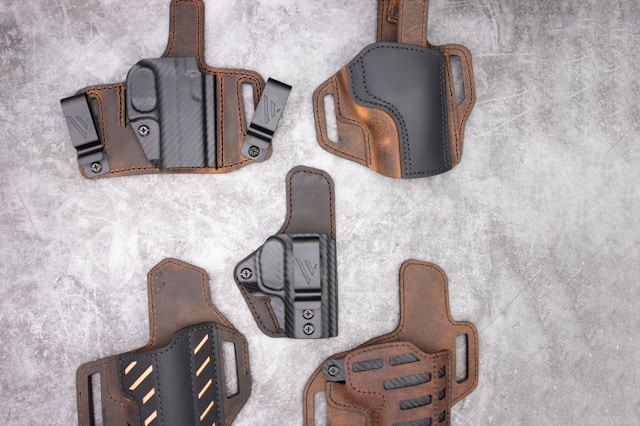Key Takeaways:
- Understanding the unique features and purposes of competition holsters.
- The key characteristics influencing shooter performance include material choice and personal fit.
- Acknowledging the critical role of safety, training, and maintenance in using competition holsters.
Table of Contents:
- Understanding Competition Holsters
- Key Features to Consider
- Materials and Craftsmanship
- Match Regulations and Compliance
- Popular Holster Styles
- Personalization and Adjustability
- Training and Familiarization
- Safety Considerations and Best Practices
- Upkeep and Maintenance
- Making the Final Decision
Understanding Competition Holsters
Entering the competitive shooting world requires skill, practice, and the right equipment. A critical component of a shooter’s gear is the competition holster, which differs significantly from the everyday carry (EDC) alternatives. Designed for the fast-paced environment of shooting competitions, suitable competition holsters prioritize rapid access to the firearm while maintaining safety and offering durability across multiple events. The balance between accessibility and retention is finely tuned to meet the high standards expected in competitive shooting scenarios.
Key Features to Consider When Choosing a Competition Holster
When selecting a holster for competitive use, the primary factors revolve around security, speed, and comfort. The retention mechanism must ensure the firearm does not dislodge accidentally during rapid movement yet allows for a seamless draw when milliseconds count. Additionally, the shooter’s comfort cannot be compromised; a well-fitted holster should feel like a natural extension of the body without causing distraction or discomfort, particularly during extended periods of use in various stances and positions that competitions often demand.
Materials and Craftsmanship in Holster Performance
The choice of material for a competition holster is a blend of personal preference and performance. Leather, known for its traditional look and feel, molds to the firearm’s and user’s shape, becoming more comfortable over time, while modern synthetics offer lightweight and consistent support. Regardless of material, the craftsmanship is essential. A well-crafted holster will have careful stitching, robust fixtures, and a thoughtful design accentuating aesthetics and function. A well-engineered holster can improve shooting times and accuracy by ensuring consistent draw and firearm alignment.
Match Regulations and Holster Compliance
Before settling on a holster, it’s crucial to understand the regulations of the specific shooting sport. Different competitions, be it USPSA, IDPA, or three-gun events, have distinct rules about the types of holsters permitted. Some may require holsters that cover the trigger guard entirely, while others restrict the holster’s position on the body. Ignorance of these regulations can lead to disqualification or, at the very least, discomfort during events.
Popular Holster Styles for Competitive Shooters
The competition holster market offers many styles tailored to different shooters and disciplines. For rapid access, holsters are a common choice; their position on the belt fosters quicker draw times than Inside the Waistband (IWB) options, though they are less discreet. A Drop-leg holster, another style, offers an alternative that places the pistol at thigh level, which can be advantageous in certain active shooting sports. The intention should always be to find a blend that contributes positively to the shooting technique while meeting the required standards for the competition.
Personalization and Adjustability
Adjusting the holster to suit personal needs can significantly enhance the user’s comfort and performance. Adjustments such as cant angle, retention tightness, and ride height personalize the holster to the shooter’s body mechanics and preferences. Some holsters offer interchangeable parts or modular systems that allow for refinement over time or as the shooter’s style evolves. This level of customization ensures that the user can fine-tune their equipment to complement their shooting stance, grip, and draw technique.
Training and Familiarization with Your Competition Holster
The best equipment in the world is only helpful if one is adept at using it. This principle applies to competition holsters, where familiarity and training are as crucial as the material and build of the holster itself. Consistent practice with the holster will enhance the shooter’s quickness and reliability under pressure, mirroring the conditions faced during competition. This practice also allows shooters to identify any potential issues or adjustments needed to maximize performance when it counts.
Safety Considerations and Best Practices
Safety is paramount in all aspects of firearm usage, but especially so in competitive environments where adrenaline and pressure can run high. A competition holster must enable speed and ensure the firearm is secured safely when not in use, preventing accidental discharge. Regular drills and proficiency in handling the holster can mitigate risks and embed safe practices in handling, drawing, and re-holstering the firearm.
Upkeep and Maintenance for Longevity
Regular maintenance significantly extends the life of a competition holster. Materials like leather benefit from conditioning to remain supple and durable, while synthetic holsters might need occasional checks for potential weaknesses in their structure. Regularly inspecting the holster for wear, particularly in high-friction areas, is essential. A well-maintained holster ensures predictability and safety, maintaining the integrity required for the highest levels of competition.
Making the Final Decision: What to Look For Before Purchase
Remember to account for all variables discussed when deciding on a competition holster. Seek credible sources of information and consult with experienced shooters to understand which features will serve you best in the context of the sports you wish to engage in.
